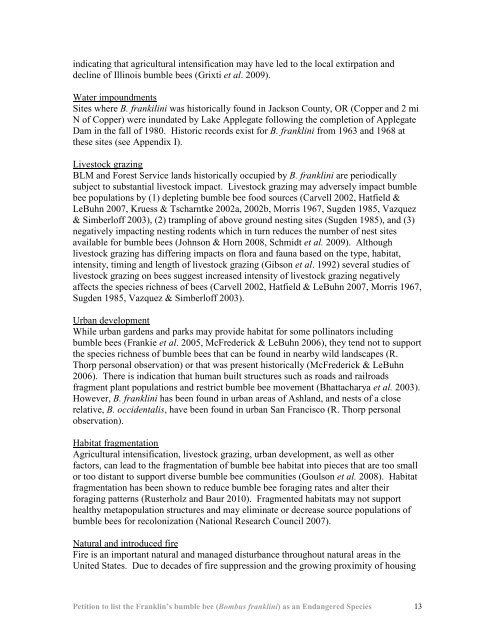Franklin's bumble bee - The Xerces Society
Franklin's bumble bee - The Xerces Society
Franklin's bumble bee - The Xerces Society
You also want an ePaper? Increase the reach of your titles
YUMPU automatically turns print PDFs into web optimized ePapers that Google loves.
indicating that agricultural intensification may have led to the local extirpation and<br />
decline of Illinois <strong>bumble</strong> <strong>bee</strong>s (Grixti et al. 2009).<br />
Water impoundments<br />
Sites where B. frankilini was historically found in Jackson County, OR (Copper and 2 mi<br />
N of Copper) were inundated by Lake Applegate following the completion of Applegate<br />
Dam in the fall of 1980. Historic records exist for B. franklini from 1963 and 1968 at<br />
these sites (see Appendix I).<br />
Livestock grazing<br />
BLM and Forest Service lands historically occupied by B. franklini are periodically<br />
subject to substantial livestock impact. Livestock grazing may adversely impact <strong>bumble</strong><br />
<strong>bee</strong> populations by (1) depleting <strong>bumble</strong> <strong>bee</strong> food sources (Carvell 2002, Hatfield &<br />
LeBuhn 2007, Kruess & Tscharntke 2002a, 2002b, Morris 1967, Sugden 1985, Vazquez<br />
& Simberloff 2003), (2) trampling of above ground nesting sites (Sugden 1985), and (3)<br />
negatively impacting nesting rodents which in turn reduces the number of nest sites<br />
available for <strong>bumble</strong> <strong>bee</strong>s (Johnson & Horn 2008, Schmidt et al. 2009). Although<br />
livestock grazing has differing impacts on flora and fauna based on the type, habitat,<br />
intensity, timing and length of livestock grazing (Gibson et al. 1992) several studies of<br />
livestock grazing on <strong>bee</strong>s suggest increased intensity of livestock grazing negatively<br />
affects the species richness of <strong>bee</strong>s (Carvell 2002, Hatfield & LeBuhn 2007, Morris 1967,<br />
Sugden 1985, Vazquez & Simberloff 2003).<br />
Urban development<br />
While urban gardens and parks may provide habitat for some pollinators including<br />
<strong>bumble</strong> <strong>bee</strong>s (Frankie et al. 2005, McFrederick & LeBuhn 2006), they tend not to support<br />
the species richness of <strong>bumble</strong> <strong>bee</strong>s that can be found in nearby wild landscapes (R.<br />
Thorp personal observation) or that was present historically (McFrederick & LeBuhn<br />
2006). <strong>The</strong>re is indication that human built structures such as roads and railroads<br />
fragment plant populations and restrict <strong>bumble</strong> <strong>bee</strong> movement (Bhattacharya et al. 2003).<br />
However, B. franklini has <strong>bee</strong>n found in urban areas of Ashland, and nests of a close<br />
relative, B. occidentalis, have <strong>bee</strong>n found in urban San Francisco (R. Thorp personal<br />
observation).<br />
Habitat fragmentation<br />
Agricultural intensification, livestock grazing, urban development, as well as other<br />
factors, can lead to the fragmentation of <strong>bumble</strong> <strong>bee</strong> habitat into pieces that are too small<br />
or too distant to support diverse <strong>bumble</strong> <strong>bee</strong> communities (Goulson et al. 2008). Habitat<br />
fragmentation has <strong>bee</strong>n shown to reduce <strong>bumble</strong> <strong>bee</strong> foraging rates and alter their<br />
foraging patterns (Rusterholz and Baur 2010). Fragmented habitats may not support<br />
healthy metapopulation structures and may eliminate or decrease source populations of<br />
<strong>bumble</strong> <strong>bee</strong>s for recolonization (National Research Council 2007).<br />
Natural and introduced fire<br />
Fire is an important natural and managed disturbance throughout natural areas in the<br />
United States. Due to decades of fire suppression and the growing proximity of housing<br />
Petition to list the Franklin’s <strong>bumble</strong> <strong>bee</strong> (Bombus franklini) as an Endangered Species 13
















